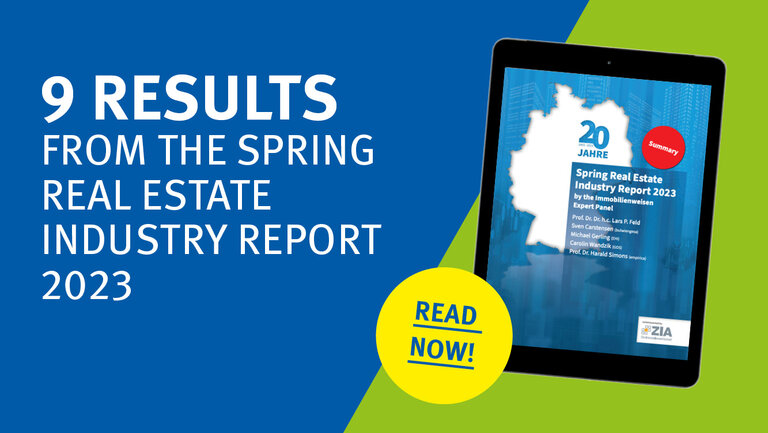In-depth market analyses, interesting forecasts and a look at current trends: The Expert Panel of the German Property Federation (ZIA) has published its annual Spring Report, providing a comprehensive insight into real estate markets. As well as offering a macroeconomic overview, the report examines individual asset classes in detail.
Reliable analysis is essential to identify development trends as early as possible, particularly in view of the current turbulent market environment with soaring construction costs, shortages of raw materials and delivery delays. It is the only way to ensure a fast and appropriate response.
The report has established itself as an important reference resource for all market players. We are proud to have been supporting the ZIA Spring Report for several years now, thus making our contribution to greater transparency in real estate markets.
The nine key findings at a glance:
- Macroeconomic development: The high inflation rate, rising financing costs, combined with material and supply bottlenecks, have led to a restrained mood in the investment market. Nevertheless, recent developments point to an improved economic outlook and thus to a much shorter and milder recession than expected.
- Office real estate: Despite economic uncertainties, the office property market has so far remained robust. The impact of remote working and necessary ESG measures remain the key topics.
- Corporate real estate: The light industrial market is proving to be largely crisis resilient. Rents increased considerably, in particular for modern properties with high-quality fitout.
- Logistics real estate: Demand remained high despite numerous upheavals. This led to a further increase in rents – modern, energy-efficient properties are in particularly high demand.
- Hotel real estate: Recovery is in sight in the hotel market. For the first time, the number of overnight stays has almost returned to pre-crisis levels. The resumption of business tourism is particularly positive.
- Retail real estate: City centers are bustling again. In 2022, brick-and-mortar retail even outperformed e-commerce. While online retail is gradually returning to normal after the pandemic peak, brick-and-mortar stores recorded a 9.3 percent increase in sales.
- Healthcare and community real estate: Demand for care homes and serviced housing remains stable, mainly due to long-term trends such as demographic change. Nevertheless, a growing supply shortage is looming.
- Residential real estate: The demand for housing is growing. It increased significantly in 2022, especially due to war-related immigration. In addition, housing completions fell by 4.2 percent to 293,500.
- Inner-city development: The structural challenges of making our inner cities more sustainable and significantly more attractive have increased considerably as a result of the crisis.
Would you like to learn more and gain detailed insights into market developments? You can download an English summary of the German report here.
